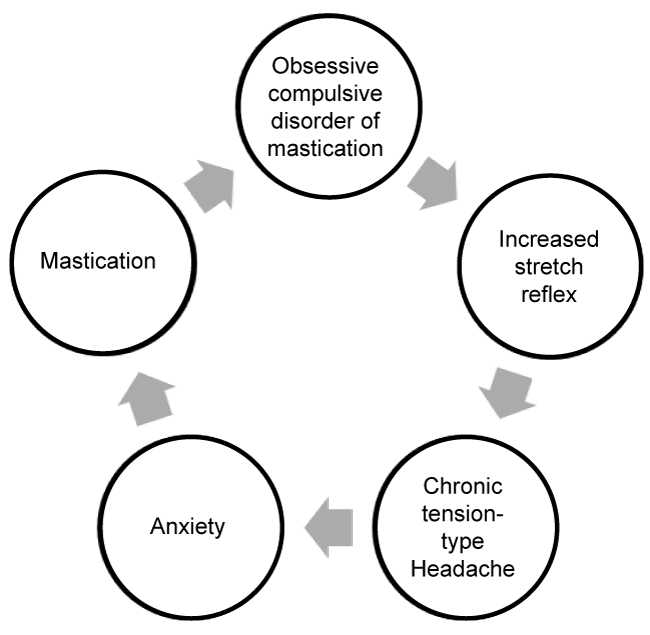Mastication is an effective coping behavior for anxiety, likely due to activity of the hypothalamic-pituitary-adrenal axis and autonomic nervous system can be attenuated by mastication [1]. Some studies showed that chewing gum was associated with lower levels of perceived stress, such as anxiety and depression [2,3]. An experiment in rats found that chewing may activate the dopaminergic system in the ventral hippocampus to suppress stress-induced anxiogenic behavior [4]. But hyperactivity of musculi masticari can be the cause of headache [5,6]. Headaches caused by bruxism were first reported by Monica WS in 1959 [7]. Later chronic headache attributed to bruxism [8] and headache attributed to hypertrophied temporal muscles [9,10] were reported. Here we present a unique case.
A 51-years-old man who had developed severe phobia, anxiety since took illicit drugs twice 10 years ago, subsequently palpitation and shortness of breath appeared, having a continuous feeling that someone would attack him and he would die soon. Only mastication can partially relieve phobia and anxiety, and continuous involuntary mastication habit with left side teeth was developed. Anxiety and depression diagnosis was made by local clinic, but he didn't take the prescribed drugs. About half year later he developed dragging and tight pain in left temporal area. The pain's verbal rating scale (VRS) was 3, and no treatment was received. 2 years later, his headache was aggravated and unbearable, VRS was 6, could be aggravated by mastication, had to stop masticating sometimes, even speak was seriously influenced. He started to take drugs mirtazapine, clonazepam, duloxetine prescribed by local neurologists, in about 2 months, his anxiety and phobia symptom were partially relieved. However, his left temporal headache and mastication habit persisted, numerous treatments had failed and daily life ability was severely impaired. This year he was admitted to our neurology ward. No focal neurologic sign was revealed by neurologic examination. Brain magnetic resonance imaging scan was normal. Temporal-mandibular joint X-ray was normal. The initial diagnosis was chronic tension-type headache, so amitriptyline 25 mg 1 time per night, eperisone 50 mg 3 times per day, and pregabalin 75 mg 2 times per day was given, but no headache relieve was achieved in two weeks, and left temporal muscle blockade with lidocaine 0.1 g and dexamethasone 5 mg failed either. Later we noticed his headache was accompanied by repetitive mastication habit of left teeth, so obsessive compulsive disorder of mastication was considered. Oxcarbazepine 0.3 g 3 times/day was given, then involuntary repetitive mastication activity was reduced, and his headache symptom was gradually improved in one week. Headache VRS reduced to 1 to 2. He continued to take the drugs, and headache symptoms and repetitive mastication habit gradually disappeared in 2 months follow-up.
Our case is a unique case which demonstrate that obsessive compulsive disorder of mastication was a cause of persist chronic headache, and other study also found association between anxiety and bruxism, resulting in facial pain and headache [11]. Temporal-mandibular joint disorder was excluded by normal temporal-mandibular joint X-ray in our case. We inferred that obsessive compulsive disorder of mastication was initiated by anxiety in our case. Some studies had suggested that Oxcarbazepine [12] and Carbamazepine [13] were effective in the treatment of obsessive compulsive disorder, the good response in our case further verified this view. Otherwise amplitude of the stretch reflexes recorded in the temporalis and masseter muscles was higher in chronic tension type headache patients than control was also reported [14]. We inferred that stretch reflex of musculi masticari was increased by obsessive compulsive disorder of mastication, which was initiated by anxiety , might indicating underlying mechanism of chronic tension-type headache in this case. Chronic headache could make anxiety even worse. The whole proposed process was illustrated by figure 1.
 Figure 1: Possible underlying mechanism of chronic headache attributed to obsessive compulsive disorder of mastication. View Figure 1
Figure 1: Possible underlying mechanism of chronic headache attributed to obsessive compulsive disorder of mastication. View Figure 1
In conclusion, our study found that obsessive compulsive disorder of mastication initiated by anxiety was a cause of chronic tension-type headache, and increased stretch reflex of musculi masticari might be the underlying mechanism.
SY guided the study and revised the manuscript. MH conceived and drafted the manuscript. ZD and XW did the literature review.